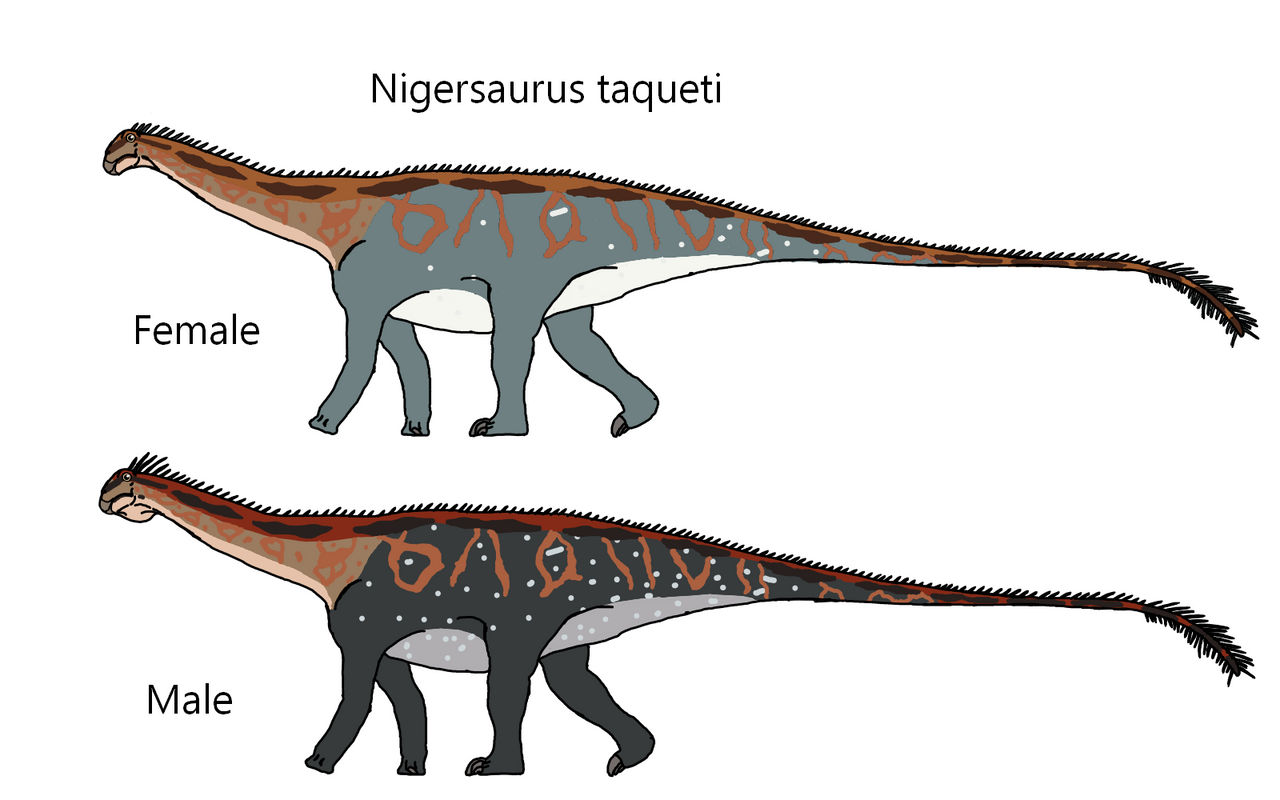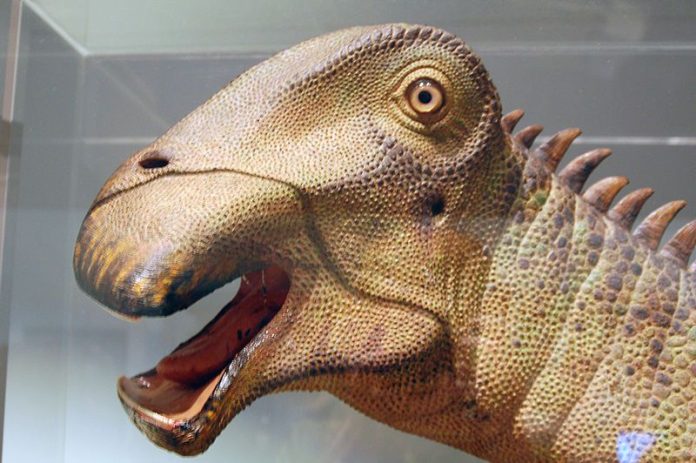Nigersaurus taqueti is a remarkable dinosaur that holds the record for having over 500 teeth. This unique herbivorous sauropod lived during the Early Cretaceous period, around 110 million years ago, in what is now the Sahara Desert of Niger. Known for its distinct dental structure and feeding habits, Nigersaurus has become a subject of fascination among paleontologists and dinosaur enthusiasts alike.
Discovery and Classification of Dinosaur Skulls
Nigersaurus was discovered in the Elrhaz Formation in Niger and was named after the country where it was found.
The genus name means “Niger reptile” and the specific name honours the palaeontologist Philippe Taquet.
Nigersaurus was initially described as a dicraeosaurid, but was later reclassified as a rebbachisaurid diplodocoid.
It is the basalmost member of the subfamily Nigersaurinae, which includes closely related genera. Nigersaurus taqueti, known for its unusual vacuum-like mouth and extraordinary dental arrangement with over 500 teeth, is a small sauropod dinosaur from the Mesozoic era.
Physical Characteristics and Behavior: Thin Bone Plates
Nigersaurus was a quadruped with a small head, thick hind legs, and a prominent tail.
As a member of the sauropod dinosaurs, Nigersaurus exhibited several unique adaptations that distinguished it from its relatives.
It had a short neck for a sauropod, with 13 cervical vertebrae. The Nigersaurus skull was delicate, with large fenestrae and thin bones, and featured unique physical attributes and adaptations. The dorsal vertebrae had paired pneumatic spaces at the base of the neural spines. The presacral vertebrae were heavily pneumatised, with thin bone plates filled with air spaces.
Habitat and Environment
Nigersaurus thrived in a lush, verdant environment that starkly contrasts with the arid Sahara Desert of today. During the mid-Cretaceous period, this region was a vibrant landscape crisscrossed by a network of rivers and lakes, creating a haven for a diverse array of flora and fauna. The climate was warm and humid, with seasonal rainfall nourishing the abundant plant life.
This rich ecosystem supported a variety of herbivorous dinosaurs, including Nigersaurus, which roamed alongside other prehistoric giants. Among its contemporaries was the formidable Sarcosuchus, a massive crocodile that added an element of danger to the landscape. The presence of ferns, horsetails, and early angiosperms indicates that the area was well-suited for ground-level browsers like Nigersaurus, which fed on these soft plants.
The lush environment provided ample food resources, allowing Nigersaurus to thrive. Its unique dental adaptations, including the rapid replacement of worn teeth, were perfectly suited to this habitat, enabling it to efficiently process the abundant vegetation. This dynamic ecosystem highlights the intricate balance of prehistoric life and the specialized adaptations that allowed creatures like Nigersaurus to flourish.
Diet and Feeding Habits: Nigersaurus Teeth
Nigersaurus was a ground-level, non-selective browser that fed on soft plants such as ferns and horsetails. The sauropod tooth battery of Nigersaurus allowed it to efficiently grind plant matter, with teeth arranged in a straight line and supported by multiple replacements. It had a unique tooth replacement rate, with each of the animal’s teeth replaced every 14 days. When a tooth wore out, the tooth beneath it would rise to take its place, ensuring continuous grazing efficiency. Its tooth crowns were worn down faster than other dinosaurian herbivores. The dental batteries consisted of more than 500 active and replacement Nigersaurus teeth. The upper jaws contained 60 columns of small, needle-shaped upper teeth, and the lower jaws had 68 very sharp teeth.
Reconstruction and Display
The discovery of the original fossil skull of Nigersaurus in Niger’s Sahara Desert was a groundbreaking moment in paleontology. Using advanced CT scan technology, scientists were able to digitally reconstruct the delicate skull, revealing fascinating details about this unusual dinosaur. The reconstruction process uncovered an extremely wide mouth filled with more than 500 replaceable teeth, a feature that set Nigersaurus apart from other dinosaurs.
The skull’s structure was remarkable, with thin bone plates and a unique dental battery designed for efficient plant processing. These thin bones, while delicate, provided insights into the evolutionary adaptations that allowed Nigersaurus to thrive as a ground-level browser. The dental batteries, consisting of numerous tooth crowns, were a key adaptation, enabling the dinosaur to replace worn teeth rapidly and maintain its feeding efficiency.
These digital reconstructions have been displayed in various museums and exhibitions, offering the public a glimpse into the anatomy and biology of Nigersaurus. By showcasing the intricate details of its skull and dental structures, these displays provide valuable educational opportunities and deepen our understanding of this fascinating dinosaur. The use of CT scans to reconstruct dinosaur skulls represents a significant advancement in paleontology, allowing scientists to explore the past with unprecedented precision and detail.
Interesting Facts and Stats: Nigersaurus Taqueti
What Dinosaur Has 500 Teeth? Discover the Unique Nigersaurus!
Introduction
In the vast and mysterious world of dinosaurs, certain species stand out not just for their size or ferocity, but for unique features that distinguish them from their prehistoric peers. Among these remarkable creatures is the Nigersaurus, a dinosaur that captures the curiosity of paleontologists and enthusiasts alike due to its astonishing number of teeth. This article delves deep into the discovery, physical characteristics, diet, and other fascinating aspects of the Nigersaurus, offering a comprehensive look at one of history’s most intriguing dinosaurs.
Discovery and Classification
The story of Nigersaurus begins in the Elrhaz Formation in Niger, a country rich with prehistoric fossils. Discovered in this region, Nigersaurus was aptly named after the country where its remains were first found, paying homage to its origins. The genus name, translating to “Niger reptile,” complements its specific name, which honors the paleontologist Philippe Taquet, who was instrumental in its study.
Initially classified as a dicraeosaurid due to its skeletal structure, further research led to a significant reclassification. Nigersaurus is now recognized as a rebbachisaurid diplodocoid, placing it as the basal member of the subfamily Nigersaurinae. This group includes several genera that share close evolutionary ties, underscoring the dinosaur’s importance in understanding sauropod diversity.
Physical Characteristics and Behavior
Nigersaurus, although a sauropod, defies many typical characteristics of its group. Unlike its long-necked relatives, it featured a relatively short neck comprised of 13 cervical vertebrae, supporting a small head. This dinosaur was a quadruped with pronounced thick hind legs and a robust tail, which likely contributed to its stability and movement.
As one of the sauropod dinosaurs, Nigersaurus’ extensive dental battery and unique skull shape set it apart from its relatives. The skeletal structure of Nigersaurus was highly specialized. Its skull was notably delicate, characterized by large fenestrae and thin bones, suggesting a lighter, perhaps more vulnerable head. The vertebrae tell a story of adaptation, with the dorsal vertebrae displaying paired pneumatic spaces at the base of the neural spines and heavily pneumatised presacral vertebrae. These features indicate an evolutionary adaptation aimed at reducing weight while maintaining structural integrity.
Diet and Feeding Habits
One of the most distinctive features of Nigersaurus is its feeding habits. This dinosaur was a ground-level browser, non-selectively feeding on soft plants like ferns and horsetails. What sets Nigersaurus apart in the dinosaur kingdom is its extraordinary tooth replacement rate. Each tooth was replaced approximately every 14 days, a rapid turnover that suggests a diet causing considerable wear.
The dental structure of Nigersaurus was nothing short of phenomenal. With over 500 active and replacement teeth at any given time, it had the most teeth of any known dinosaur. The configuration of these teeth—60 columns of small, needle-shaped teeth in the upper jaws and 68 sharp teeth in the lower jaws—allowed for efficient processing of plant material, a key adaptation for its survival.

Interesting Facts and Stats
Nigersaurus stands out not only for its dental prowess but also for its place in paleontological studies. The fossil skull of Nigersaurus is one of the first to be digitally reconstructed using CT scans, offering unprecedented insights into its anatomy and feeding habits. Living approximately 110 million years ago during the mid-Cretaceous period, Nigersaurus was a relatively small sauropod, measuring about 9 meters in length with a femur reaching up to 1 meter.
The unique skull shape, featuring a wide muzzle and extensive dental batteries, was ideally suited for grazing on low vegetation, distinguishing Nigersaurus from other sauropods that typically grazed at higher levels. This specialization suggests a niche adaptation that allowed Nigersaurus to coexist with other herbivores of its time.
Conclusion
The Nigersaurus is a prime example of the diversity and specialization found in the dinosaur world. Its unique 500-tooth dental battery not only piques scientific curiosity but also highlights the complex evolutionary paths that different dinosaur species took in adapting to their environments.
As research continues, the Nigersaurus remains a key subject in the study of prehistoric life, offering valuable insights into the ecological dynamics of the Cretaceous period. This remarkable dinosaur not only enriches our understanding of the past but also enhances our appreciation for the natural history that shapes our planet.



 Bitcoin
Bitcoin  Ethereum
Ethereum  Tether
Tether  XRP
XRP  Solana
Solana  USDC
USDC  Cardano
Cardano  TRON
TRON  Lido Staked Ether
Lido Staked Ether  Avalanche
Avalanche  Toncoin
Toncoin